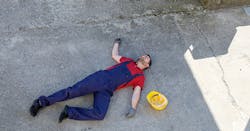Many companies proclaim, “Safety is our number one priority,” which admittedly is a great slogan and looks good on posters and websites. It doesn’t necessarily mean what it seems to suggest, though, if you’re assuming these companies consistently place the safety of their employees, or their customers, above any other consideration. With safety, as with just about anything else that can be measured and charted on a spreadsheet, there’s a bottom line.
OSHA, for instance, can tell you exactly what the cost is of a workplace accident: $129,336. That’s the current amount (as of January 2018) that a company will be fined for a workplace accident if willful neglect can be found, or if it’s a repeat offense.
According to the Centers for Disease Control and Prevention (CDC), the cost of a worker’s life is a cool million dollars (give or take a hundred thousand dollars or so), when you factor in hospitalization costs (assuming the employee lived long enough to make it to the hospital), worker’s compensation, general medical expenses, various legal costs, and property loss.
In reality, companies almost never know the real cost of workplace fatalities because they don’t factor in all of the indirect hidden costs, points out Ed Foulke, a partner with Fisher Phillips and former head of OSHA under President George W. Bush. Those hidden costs could include replacing damaged tools and equipment; time lost and overhead costs incurred when work was disrupted; lost orders or billing rights for government contracts; failure to meet production deadlines; and the cost of bad publicity. Throw in legal costs and various HR issues (loss of efficiency due to decreased morale or break-up of work crews, not to mention the difficulty in attracting new employees), and it’s safe to say that it’s difficult if not impossible to calculate the cost of a human life.
You would think, then, that companies would be extremely protective of their employees, to the point of not only being sticklers for best safety practices but going well above and beyond merely being in compliance with the standards set by regulatory agencies. And yet, workplace fatalities keep happening, and even calling them “accidents” is misleading because blatantly unsafe behavior—whether on the part of the employer or the worker—inevitably leads to bad results. Better to call these incidents “deliberates,” if you will.
Automaker Tesla, as we noted last month, is under investigation for Cal/OSHA for allegedly misidentifying workplace injuries as personal medical cases that occurred outside of work. If true, it certainly is a creative way for a company to reduce the incident rate at its facilities, especially when that company had gained notoriety for having an incident rate 31% higher than the industry average. But OSHA doesn’t give extra points for creativity.
Tesla, in fact, is one of the companies tagged on the annual “Dirty Dozen” list of safety offenders compiled by the National Council for Occupational Safety and Health (National COSH). This list—a blacklist, if you will—focuses on companies that are the most egregious at putting their employees in harm’s way, due to unsafe practices. The list is more of an unpopularity contest than a detailed accounting, since National COSH is an advocacy group whose aims include establishing and strengthening unions. But taking that into consideration, the companies on the Dirty Dozen list have shown an astonishing inability to learn from their checkered pasts.
Besides Tesla, other big companies on the list include online retail giant Amazon (seven workers have been killed at Amazon warehouses since 2013); waste disposal specialist Waste Management (the company has been cited more than 60 times by OSHA), and Case Farms, a poultry farming and processing company (Case has received 74 OSHA violations per 1,000 employees, a rate that is more than four times higher than any other poultry firm). Indeed, all of the companies on the Dirty Dozen list seem to share the same basic character flaw: They keep allowing bad things to happen to good people.
“It’s heartbreaking to see workers lose their lives when we know these tragedies could have been prevented,” says Marcy Goldstein-Gelb, co-executive director of National COSH. “Time and again, employers are warned about unsafe conditions. When companies fail to correct safety hazards, it is workers who pay the ultimate price.”
Now of course, it’s entirely in National COSH’s self-interest to publicly shame big-name companies in the hopes of spurring on union-organizing efforts, and one wonders if the advocacy group is just as gung-ho on exposing the safety incidents and fatalities at union shops. Be that as it may, when the ultimate stakes at play are worker’s lives, the only winners in this game are the workers who make it home alive at the end of the day.
